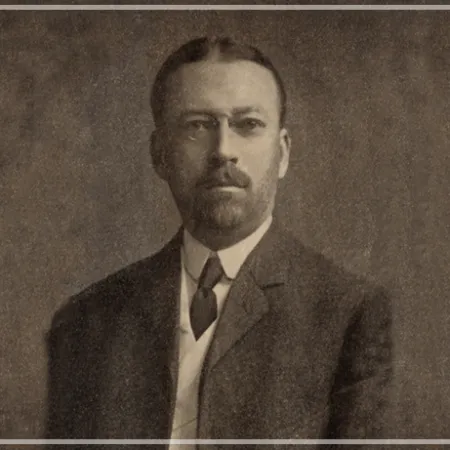
Leighton Calkins (1868-1955)

(Class of 2020)
The debut of golf’s new World Handicap System in 2020 was among the most far-reaching recent improvements in our evolving game. As noted at the time by Mike Davis, CEO of the USGA, “Golfers throughout the world will be able to play equitably, measure their success more fully and engage with the game.”
Those exact words could have easily been penned over 100 years ago by a many-faceted member of Plainfield Country Club, Leighton Calkins, who laid out the concept and process for the first USGA handicap system. Calkins was talented – a nationally recognized golf writer who was also the mayor of Plainfield from 1915-1920 and builder of its City Hall. He conceived, founded and nurtured what is today the nation’s oldest junior golf championship, the Met Junior Championship, when he hosted the event at his home club in 1912.
All impressive accomplishments, but Calkins’ enduring legacy is as the father of golf’s handicap system, the convention that allows literally any golfer in the world to compete equitably with another, but not without input from the player, his or her club / course and an overarching golf governing body. With today’s version of Calkins’ system, you could actually tee it up in, say, Tokyo, in a foursome that includes Justin Rose, Justin Timberlake and Jennifer Aniston – and have a fair shot at coming out on top.
Until Calkins came along, the concept of handicapping was nearly as unruly as social media is today, with individual clubs divining their relative toughness subjectively while golfers negotiated their relative abilities every time they stood on the first tee. Consequently, until / unless the players became familiar with the course and their opponents’ games, the concept of an “equitable” and “fair” match was often elusive. This lack of consistency undercut golf’s social and honorable tendencies and was an impediment to the growth of the game.
In March 1905, the 37-year-old Calkins introduced his methodology, which adapted a British system of averaging the three best scores, in a work titled A System for Club Handicapping. Calkins’ plan addressed most aspects of today’s handicap system. He patiently implemented the system by starting small, first at Plainfield in 1905, and then honing it over several years as the first Handicap Committee Chairman at both the NJSGA and then the MGA.
A busy man, Calkin also served on the USGA’s Executive Committee, where he found a receptive audience to his ideas. Calkin’s handicap system and his approach for socializing it had proven its merit in club, local and regional play. At a meeting on October 11, 1911, at the Baltusrol Golf Club, the USGA adopted a modified form of Calkins's system, the first USGA Handicap System. Applying to all of the day’s 324 USGA clubs, its primary purpose was to provide a basis for accepting entries into the US Amateur, just a sliver of what the system has become today.
Calkins’ system was replete with common-sense requirements. For example, he insisted that each club have its own handicap committee to provide local guidance, oversight and enforcement. He viewed his responsibilities as Plainfield’s first handicap chairman as the prototype for the role.
Calkins also introduced the concept of a par rating. Not immediately adopted by the USGA, its original decision was to allow clubs to determine their own ratings. A frustrated Calkins protested vehemently, calling the practice “useless” and a “farce.” He believed there was no way the clubs themselves could be objective and unbiased when calculating these ratings; universal criteria was needed for each course to determine its degree of playability and toughness. The USGA quickly came around to Calkin’s point of view.
His par-rating idea was based on the abilities of New Jersey’s Jerry Travers, who had won the U.S. Amateur in 1907 and 1908 and would go on to win two more U.S. Amateurs and the 1915 U.S. Open. Rating courses based on the expected score of the national amateur champion became the standard and official USGA Course Ratings – an ingredient from which all players would give and receive strokes – were soon issued for the USGA by state and regional golf associations, just as they are today.
By 1914, Calkins' rating concept began to appear in articles in influential British golf magazines. A rating procedure was developed in Britain by 1925 and a Joint Advisory Committee of the British Isles was formed to assign “Standard Scratch Scores” (known in the US as course ratings) to its golf courses. Calkins’ system had gone worldwide.
Tweaks have been made over the years to Calkin’s system as technology has evolved and as more relevant factors emerged, but the foundations of Calkin’s system remain as they were over a hundred years ago.
Calkins almost surely didn’t anticipate that his handicap system would be a powerful engine for the growth of organizations such as the USGA, the Royal and Ancient and the hundreds of golf associations around the world that were created to administer handicaps as well conduct tournaments.
Golf remains today among the few sports that strive for equity among the millions who play it recreationally. Calkins’ genius lay in adopting many of the best handicapping ideas from both Great Britain and the US and then applying common sense and process to a pastime that – while growing fast – needed some help.
It’s a similar calculus that drives today’s move to the WHS, a process that incorporates best golf handicapping practices from across the globe while applying new technology and a healthy dose of common sense. The new WHS will carry on Calkins concepts for some time.
Clearly a man of both common sense and vision, Calkins died in 1955 at age 87. He lived to witness the fruits of his diverse labors, from exceptional young golfers to beautiful civic buildings to a worldwide golf handicap system – we should all be so fortunate.
